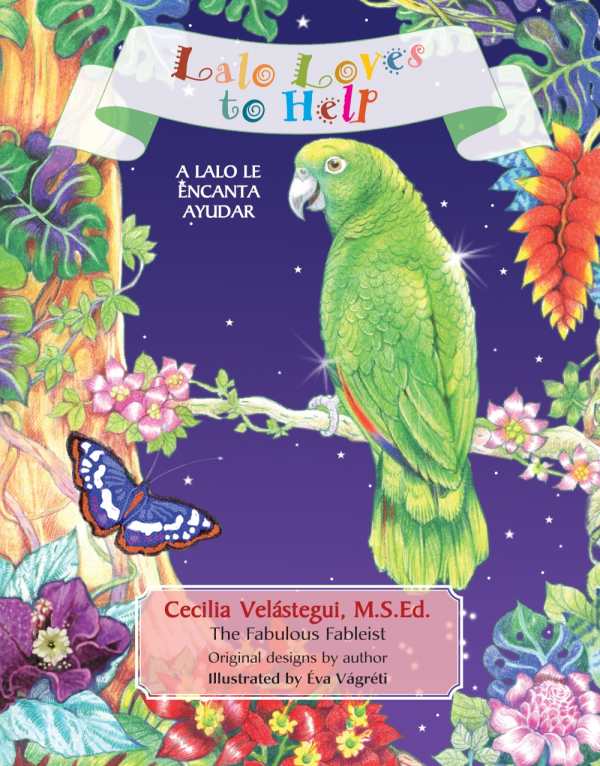Lalo Loves to Help
A Lalo le encanta ayudar
Vivid illustrations of the Ecuadorian rain forest and its animal inhabitants add to the story of various creatures solving a mystery.
Talking animals and indigenous peoples come together in Lalo Loves to Help: A Lalo le encanta ayudar, Cecilia Velástegui’s unique multilingual children’s fable that teaches the importance of kindness as well as language skills.
Central to the story is Lalo, a kind-hearted Amazonian parrot, who is famous for his song “Lalalo this, lalalo that, if you need help, call LALALALOHH!” He and a cast of other feathered, furry, and scaled creatures are getting ready for an upcoming opera performance when they encounter an elderly woman alone in the rain forest. The anthropomorphized parrots, snakes, and monkeys must work together to solve the mystery of this stranger and find an animal that speaks her curious language.
Velástegui, referred to as the Fabulous Fableist, uses characters with grand personalities to introduce amikri, the Amazonian oath of friendship. There’s Yoli, the anaconda with a diva side; Pedro, the timid spider monkey; twin parrots who are perhaps a little too competitive; and other rain forest animals such as tapirs and frogs. Illustrator Éva Vágréti, working from original designs by the author, presents vivid, intensely colored pictures of the lush Ecuadorian landscape to supplement the short but dramatic tale.
Lalo Loves to Help is presented bilingually, with English in red text and the corresponding Spanish translation in black. Adding to the dynamic text are sung lyrics—denoted by italics and musical notes—as well as other foreign words, also presented in italics. This amounts to a very cluttered page layout that makes the text awkward to read aloud. Also taking away from the otherwise stellar story is the too busy cover design in which a cluttered background image fights with too many different fonts and text boxes.
Beyond English and Spanish, select words of both Italian and Teteté, an indigenous language of the Amazon, are used in the book. As the animals prepare for their performance and work together to help the woman, Lalo and his friends demonstrate how to live in a multilingual community. Their adventures also introduce young readers to environmentalism as they bemoan the pollution of their river, as well as cultural preservation as they seek to help the indigenous woman.
Although the tone is generally playful, there are some darker themes that make the story more suitable for ages seven and up. Yoli the anaconda slithers around ominously, hinting that she might eat the others, and Pedro makes reference to a nearby tribe that uses monkey guts to make their mouth harps.
Lalo Loves to Help brings the beauty of the Amazon into homes and classrooms, and uses the magic of nature to illustrate the worthwhile theme of friendship and the importance of oral tradition.
Reviewed by
Amanda McCorquodale
Disclosure: This article is not an endorsement, but a review. The publisher of this book provided free copies of the book and paid a small fee to have their book reviewed by a professional reviewer. Foreword Reviews and Clarion Reviews make no guarantee that the publisher will receive a positive review. Foreword Magazine, Inc. is disclosing this in accordance with the Federal Trade Commission’s 16 CFR, Part 255.

